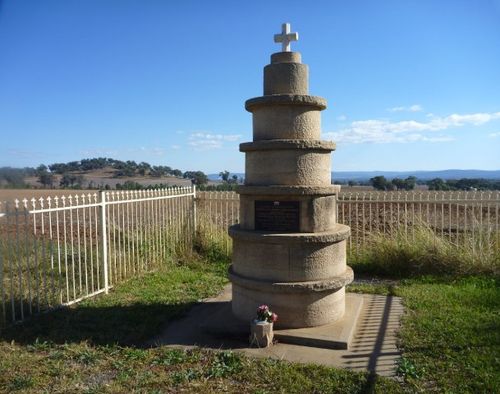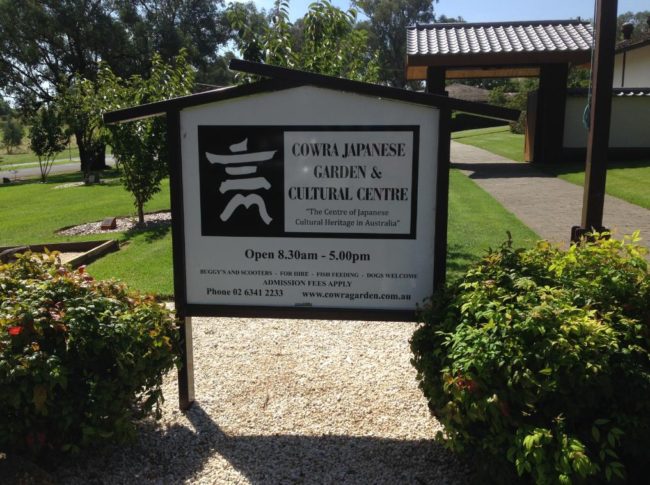The farming town of Cowra is situated over 300km west of Sydney. During World War II, a large prisoner of war (POW) camp was constructed outside the town so as to be well away from the coast and the bulk of the Australian population in the capital cities.
No. 12 POW Compound was one of the largest in the country was made up of four POW camps covering more than 30 hectares. It housed 4000 military personnel and civilians detainees from the Axis powers – mainly Japanese, but also Italians, Germans, Chinese, Indonesians and Koreans.
Each camp was encircled by multiple barbed wire fences. Prisoners first lived in huts, but eventually included its own store, kitchen, mess huts, showers, shops and vegetable gardens. They were looked after by the First World Aussies, in stark contrast to barbaric torturous treatment in which the Japs treated captured Australian prisoners across South East Asia.
 Australians were right to be fearful of the Japs after hearing what they did invading across East Asia
Australians were right to be fearful of the Japs after hearing what they did invading across East Asia
Of all the prisoners housed in Australia during the war the Japanese were undoubtedly the most bitter and resentful. Under the Japanese rules of war (known as the Bushido code) prisoners were disgraced persons. Every soldier had an obligation to die for the Emperor and if the enemy succeeded in capturing him he was expected to kill himself.
Third World savagery. Whatever. The Aussies couldn’t even begin to comprehend this attitude and saw most of the Japanese prisoners as surly and fanatical.
Earlier, on Friday 4, in accordance with the Geneva Convention, notice was given of a transfer of all Japanese prisoners below the rank of Lance Corporal from Cowra to the Hay Prisoner of War Camp.
At 0150 hours on Saturday 5 August 1944 an unauthorized bugle was heard in camp B and immediately thereafter 1,104 Japanese POWs rioted and staged a mass breakout. Armed with knives, baseball bats, studded clubs with nails and hooks, and garotting cords, they rushed from their huts and attacked the barbed wire fences of the compound.
 The cache of weapons used by the rioting Japs.
The cache of weapons used by the rioting Japs.
The outer fence was stormed in two places, with the prisoners using blankets and baseball gloves to minimize the damage inflicted by the barbed wire fencing.

359 POWs escaped, while four Australian soldiers of the 2/8th Australian Infantry Battalion and more than 250 Jap POWs were killed. Some committed suicide, others were killed by machine guns, while those left standing were captured and sent back to camp within 10 days.
Others set fire to eighteen of the camps twenty huts while those incapable of activity committed suicide by hanging or stabbing themselves, their bodies being burnt in the fires. Those that did not want to become involved were murdered by their comrades.
The Australian guards thought the Japanese were attempting to take over the camp. Actually, they were attempting to kill themselves.
One Jap group attacked the crew of a Vickers .303 heavy machine gun that was stationed outside the camp. Members of the 22nd Garrison Battalion opened fire, causing a large number of casualties.
Really good against escaping knife-wielding Japs heading into Cowra
(Made in Melbourne at Vickers Ruwolt at the Richmond factory)
During the ensuring nine days 334 prisoners were retaken, of which 25 were dead. Of the dead, 11 were found hanging from trees and two had been killed by trains.
Never likely to be successful, the breakout resulted in the death of 231 Japanese prisoners with a further 108 wounded. All survivors were recaptured in the surrounding countryside in the days that followed.
One Australian Officer was killed along with three Australian other ranks, while four others were wounded.
It has been called the ‘night of a thousand suicides‘. Dumb ignorant bastards.
After the drama of the breakout, most of the Japanese POWs were transferred from Cowra to another POW camp in Hay, NSW, where the prisoners were held in high security.
No. 12 Camp stayed in operation until January 1947, when the last Japanese and Italian prisoners were repatriated back to from whence they came.
Yet there is no evidence to suggest that the Australian authorities treated the Japanese prisoners any differently to any other group. Unlike the Italians, the barbaric Japs could not be trusted, and so were not permitted to leave the camps to work on the farms. Otherwise they received the same rations (no sushi) and were subject to the same discipline.
At no time was there any attempt to wreak revenge on the Japanese for their treatment of Australian prisoners. Unfortunately this attitude was misinterpreted by some of the Japanese as weakness and on several occasions they pushed matters as far as they could by refusing to work when ordered, refusing to turn up on parades and refusing to salute Australian officers. Had Australian prisoners acted in the same fashion in Japanese POW camps their punishment would have been severe.
Australian Private Benjamin Gower Hardy and Private Ralph Jones were on duty at the No. 12 Prisoner of War Camp, as members of a Vickers machine gun crew, guarding the prisoner of war compound, in which were interned over 1,000 Japanese prisoners of war. On the night of 4-5 August 1944 the Japanese prisoners, armed with knives, baseball clubs, and other weapons, staged a mass outbreak, stormed over the perimeter and bore down on the machine gun crew. Privates Jones and Hardy stood their ground and continued to work the gun until bashed to death, displaying outstanding gallantry and devotion to duty in their fight against an overwhelming onslaught of fanatical Japanese. They met their deaths in the true Aussie spirit of sacrifice for their country. Both were posthumously awarded the George Cross.
Private Charles Henry Shepherd (below) was also Killed in Action by the escaping Japanese POWs. He was aged 31 years. Lieutenant Harry Doncaster was killed when ambushed during the recapture of the prisoners.

Lest We Forget
A Military Court of Inquiry investigated the incident, and a summary of its findings was read to the House of Representatives by Prime Minister John Curtin on 8 September 1944. The summary indicated the following:
- that conditions at the camp were fully in accordance with the International Convention;
- that no complaints regarding treatment had been made by or on behalf of the Japanese prior to the incident, which appeared to have been a premeditated and concerted plan of the prisoners;
- that the actions of the Australian garrison in resisting the attack averted greater loss of life, and that firing ceased as soon as control was assured; and
- that many of the dead had died by suicide or by the hand of other prisoners, and that many of the wounded had suffered self-inflicted wounds.
Curtin’s statement also noted that the attack was characterised by ‘a suicidal disregard of life’.
The Japs were just ignorant fanatics. They deserve no memorial garden at Cowra, but the four Aussies do.
This is Lieutenant Harry Doncaster’s lonely memorial out on Canowindra Road.

But no self-respecting Australian should visit the Cowra Japanese Gardens and Cultural Centre. It was part-funded by Mitsubishi, same Jap company that made the Zeros which bombed Darwin.

The place is even staffed by Japs.
Apparently most Japanese today are ignorant of the Cowra breakout. They don’t learn history and remain arrogant and ignorant.
Nothing changes. Glad we didn’t buy their bloody subs.
